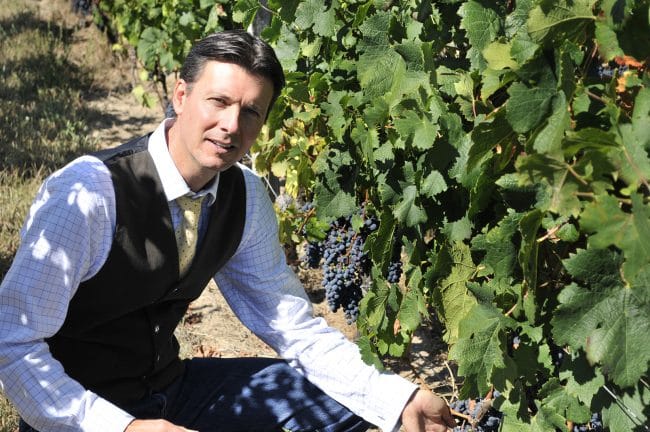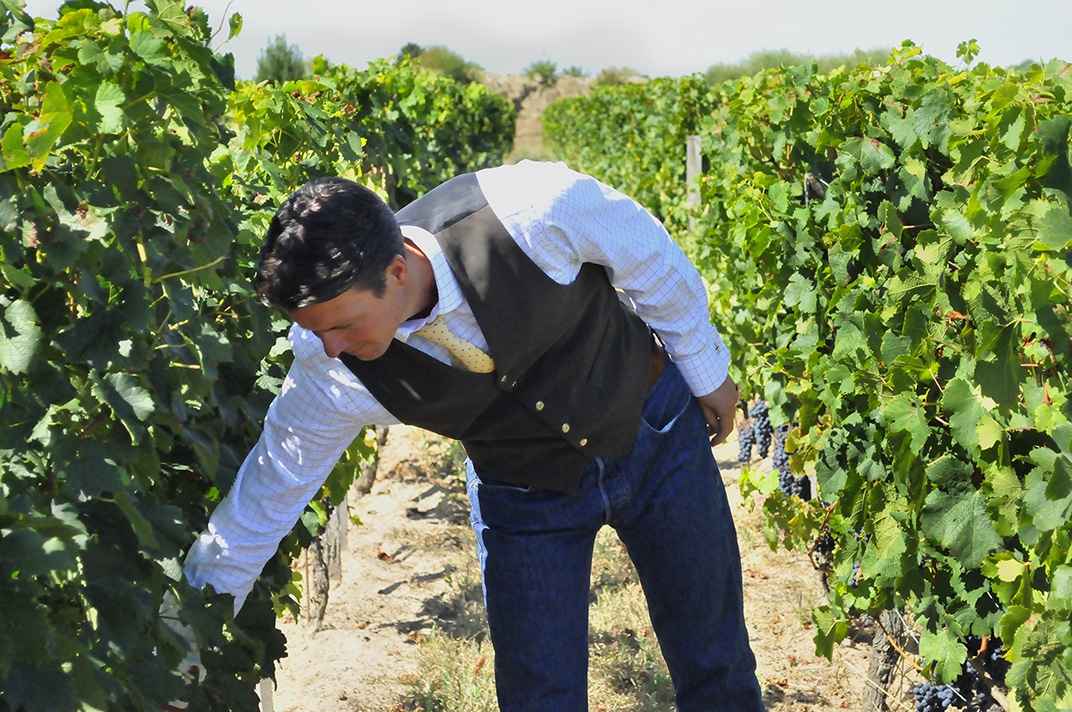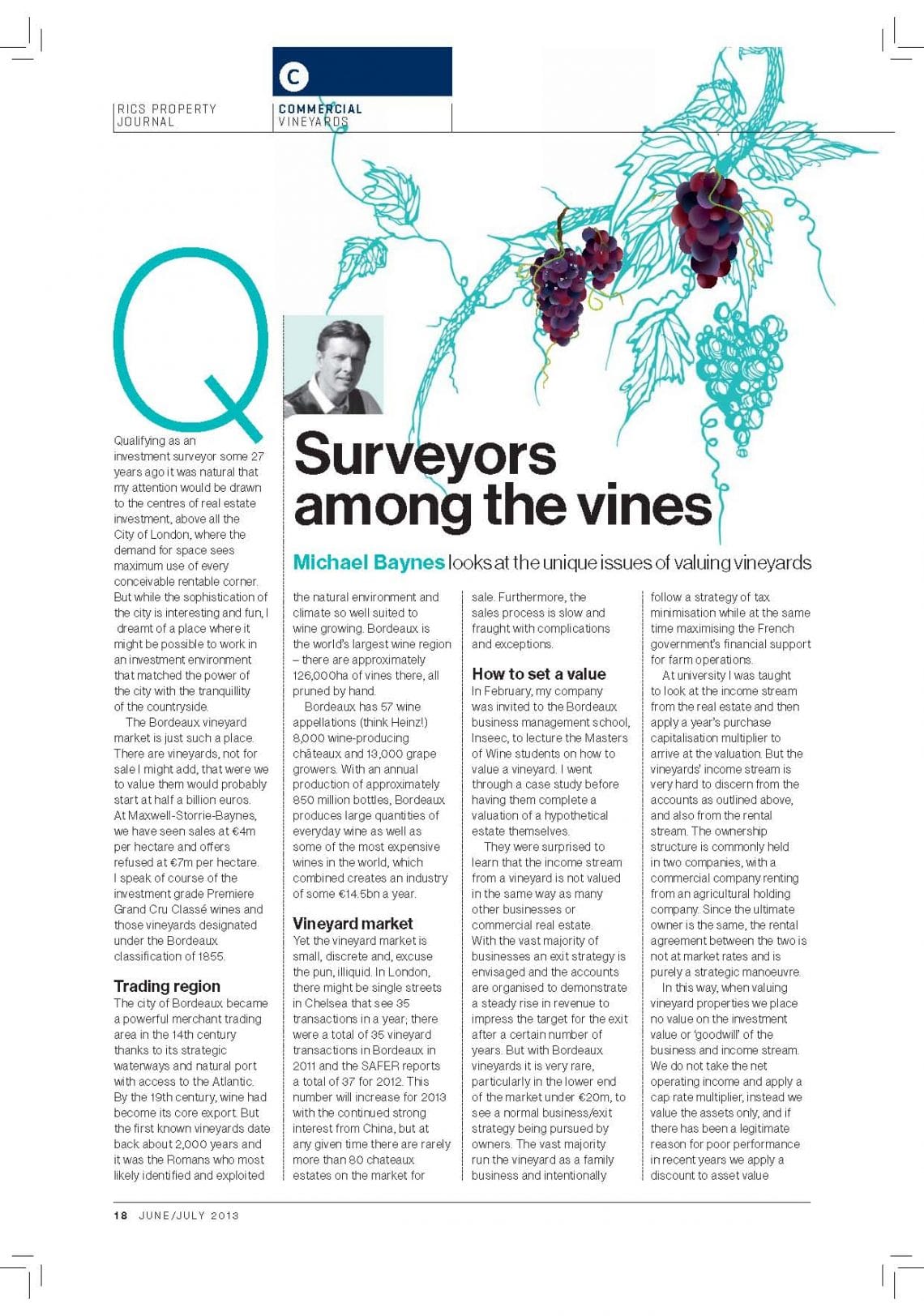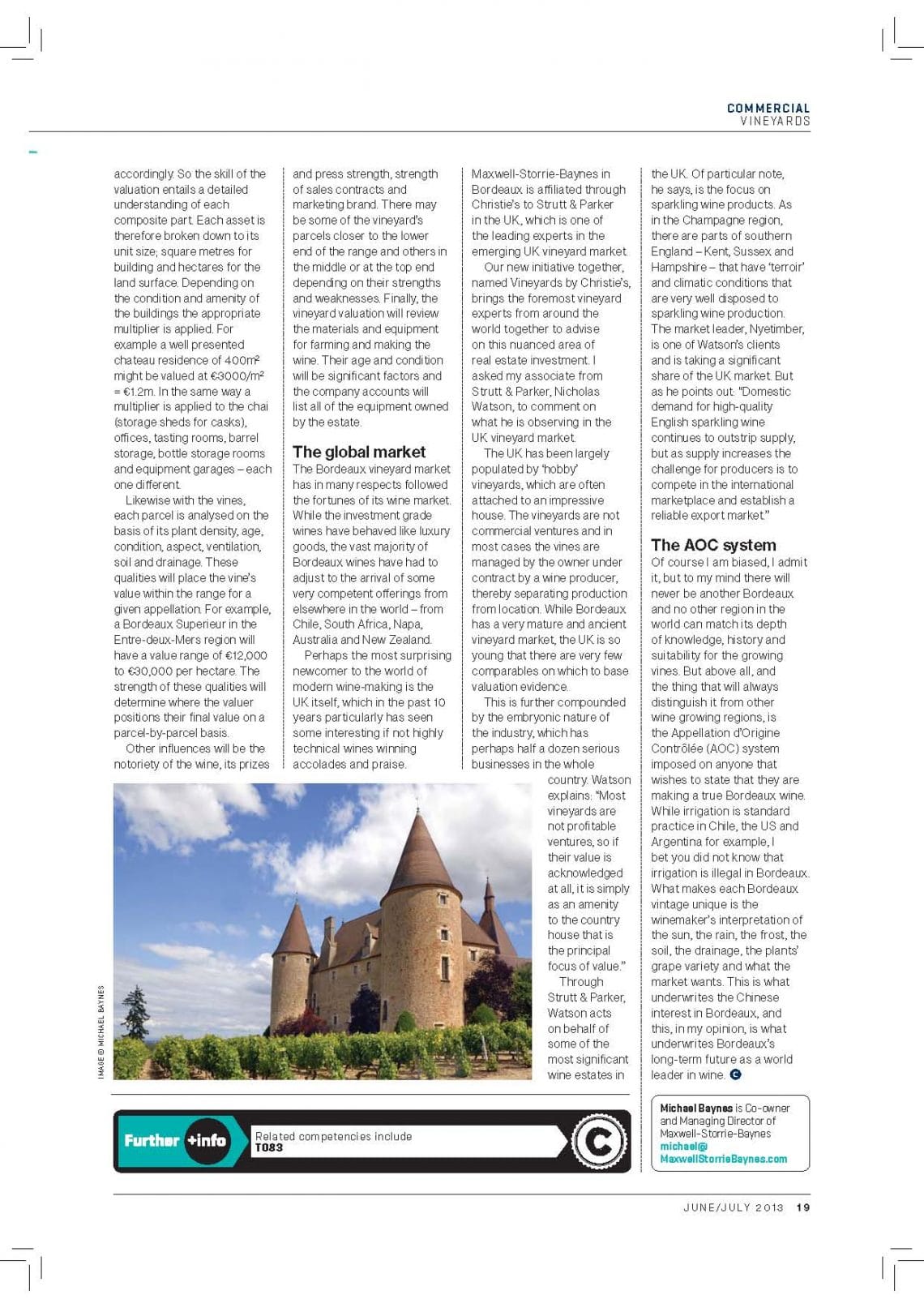Michael Baynes looks at the unique issues of valuing vineyards as reported in the prestigious RICS Property Journal June/July edition 2013. Qualifying as an investment surveyor some 27 years ago it was natural that my attention would be drawn to the centres of real estate investment, above all the City of London, where the demand for space sees maximum use of every conceivable rentable corner. While the sophistication of the city is interesting and fun, I dreamt of a place where it might be possible to work in an investment environment that matched the power of the City with the tranquillity of the countryside.
The Bordeaux vineyard market is just such a place. There are vineyards, not for sale I might add, that were we to value them would probably start at half a billion euros. We have seen sales at €4m per hectare and offers refused at €7m per hectare. I speak of course of the investment grade Premiere Grand Cru Classé wines and those vineyards designated under the Bordeaux classification of 1855.
Trading region
The city of Bordeaux became a powerful merchant trading area in the 14th century thanks to its strategic waterways and natural port with access to the Atlantic. By the 19th century, wine had become its core export. But the first known vineyards date back about 2,000 years and it was the Romans who most likely identified and exploited the natural environment and climate so well suited to wine growing. Bordeaux is the world’s largest wine region – there are approximately 126,000ha of vines there, all pruned by hand.
Bordeaux has 57 wine appellations (think Heinz!) 8,000 wine-producing châteaux and 13,000 grape growers. With an annual production of approximately 850 million bottles, Bordeaux produces large quantities of everyday wine as well as some of the most expensive wines in the world, which combined creates an industry of some €14.5bn a year.
Vineyard market
Yet the vineyard market is small, discrete and, excuse the pun, illiquid. In London, there might be single streets in Chelsea that see 35 transactions in a year; there were a total of 35 vineyard transactions in Bordeaux in 2011 and the SAFER reports a total of 37 for 2012. This number will increase for 2013 with the continued strong interest from China, but at any given time there are rarely more than 80 chateaux estates on the market for sale. Furthermore the sales process is slow and fraught with complications and exceptions.
How to value a vineyard
In February, Vineyards-Bordeaux was invited to the Bordeaux business management school, Inseec, to lecture the Masters of Wine students on how to value a vineyard. I went through a case study valuation before having the students complete a valuation of a hypothetical estate themselves.
They were surprised to learn that the income stream from a vineyard is not valued in the same way as many other businesses or commercial real estate. With the vast majority of businesses there is an exit strategy envisaged and the accounts are organised to demonstrate a steady rise in revenue to impress the target for the exit after a certain number of years. But with Bordeaux vineyards it is very rare, particularly in the lower end of the market under €20m, to see a normal business/exit strategy being pursued by owners. The vast majority of owners own the vineyard as a family business and intentionally follow a strategy of tax minimisation while at the same time maximising the French government’s financial support for French farm operations. At university I was taught to look at the income stream from the real estate and then apply a capitalisation multiplier to arrive at the valuation. But the vineyards’ income stream is very hard to discern from the accounts as outlined above, but also from the rental stream. The ownership structure of a vineyard is commonly held in two companies, with a commercial company renting from an agricultural holding company. Since the ultimate owner is the same, the rental agreement between the two is not at market rates and is purely a strategic manoeuvre.
In this way, when valuing vineyard properties we place no value on the investment value or ‘goodwill’ of the business and income stream. We do not take the Net Operating Income and apply a Cap rate multiplier, instead we value the assets only, and if there has been a legitimate reason for poor performance in recent years we apply a discount to asset value accordingly. The skill of the valuation therefore entails a detailed understanding of each composite part of the whole. Each asset part is therefore broken down to its unit size; square metres for building and hectares for the land surface. Depending on the condition and amenity of the buildings the appropriate multiplier is applied. For example a well presented chateau residence of 400 square metres might be valued at €3000/m2 = €1.2m. In the same way a multiplier is applied to the chai (storage sheds for casks), offices, tasting rooms, barrel storage, bottle storage rooms and equipment garages. Each one will have a different multiplier. Likewise with the vines, each parcel is analysed on the basis of its plant density, age, condition, aspect, ventilation, soil and drainage. These qualities will place the vine’s value within the range for a given appellation. For example, a Bordeaux Superieur within the Entre-deux-Mers region will have a value range of €12,000 to €30,000 per hectare. The strength of these qualities will determine where the valuer positions their final value on a parcel by parcel basis. Other influences will be the notoriety of the wine, its prizes and press strength, strength of sales contracts and marketing brand. There may be some of the vineyard’s parcels closer to the lower end of the range and others in the middle or at the top end of the range depending on their strengths and weaknesses. Finally the vineyard valuation will review the materials and equipment for farming and making the wine. Their age and condition will be significant factors and the company accounts will list out all of the equipment owned by the estate.
The global vineyard market and the UK
The Bordeaux vineyard market has in many respects followed the fortunes of the Bordeaux wine market. While the investment grade wines have behaved like luxury goods, the vast majority of Bordeaux wines have had to adjust to the arrival of some very competent offerings from elsewhere in the world. We are all familiar with the wonderful wines from Chile, South Africa, Napa, Australia and New Zealand. Perhaps the most surprising newcomer to the world of modern wine making is the UK itself, which in the past 10 years particularly, has seen some interesting if not highly technical wines winning more and more accolades and praise. Vineyards-Bordeaux in Bordeaux, is affiliated through Christie’s to Strutt & Parker in the UK who are one of the leading experts in the emerging UK vineyard market. Our new initiative together, named Vineyards by Christie’s, brings the foremost vineyard experts from around the world together to advise on this nuanced area of real estate investment. I asked my associate from Strutt & Parker, Nicholas Watson, to comment on what he is observing in the UK vineyard market.
The UK has been largely populated by ‘hobby’ vineyards often attached to an impressive house . The vineyards are not commercial ventures and in most cases the vines are managed by the owner as a hobby or under contract by a wine producer, thereby separating production from location. Whilst Bordeaux has a very mature and ancient vineyard market, the UK is so young that there are very few comparables to base valuation evidence on. This is further compounded by the embryonic nature of the industry itself which has perhaps half a dozen serious businesses in the whole country. Watson explained that ‘most vineyards are not profitable ventures, so if their value is acknowledged at all, it is simply as an amenity to the country house that is the principal focus of value.’
Through Strutt & Parker, Watson acts on behalf of some of the most significant wine estates in the UK, and is well placed to comment on the UK vineyard industry. Of particular note is the focus on sparkling wine products. Like the Champagne region, there are parts of southern England – Kent, Sussex and Hampshire – that have ‘terroir’ and climatic conditions that are very well disposed to sparkling wine production. The market leader, Nyetimber, is one of Watson’s clients and is taking a significant share of the UK market but as Watson points out, ‘domestic demand for high quality English sparkling wine continues to outstrip supply, however as supply increases the challenge for English producers is to compete in the international market place and establish a reliable export market.’
Of course I am biased, I admit it, but to my mind there will never be another Bordeaux and no other region in the world can match its depth of knowledge, history and suitability for the growing vines. But above all, and the thing that will always distinguish it from other wine growing regions, is the AOC (Appellation d’Origine Contrôlée) system imposed upon anyone that wishes to state that they are making a true Bordeaux wine. While irrigation is standard practice in Chile, the US and Argentina for example, I bet you did not know that irrigation is illegal in Bordeaux. This is what makes each Bordeaux vintage unique – it is the winemaker’s interpretation of the sun, the rain, the frost, the soil, the drainage, the plants’ grape variety and what the market wants. This is what underwrites the Chinese interest in Bordeaux, and this, in my opinion, is what underwrites Bordeaux’s long term future as a world leader in wine.
Written by Michael Baynes



